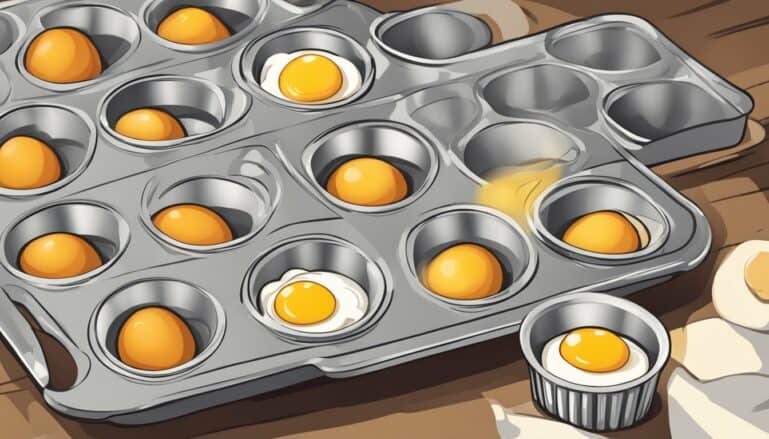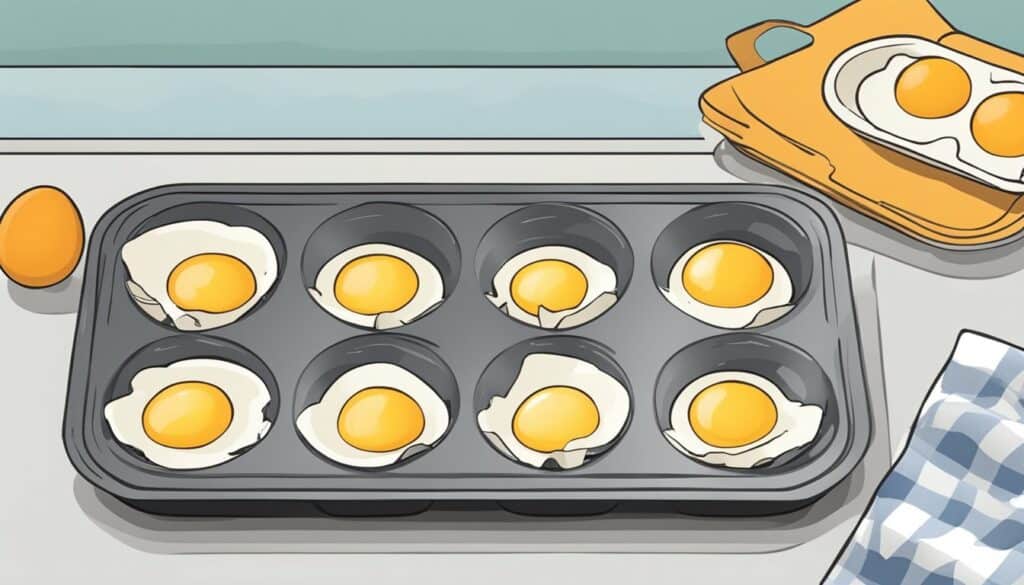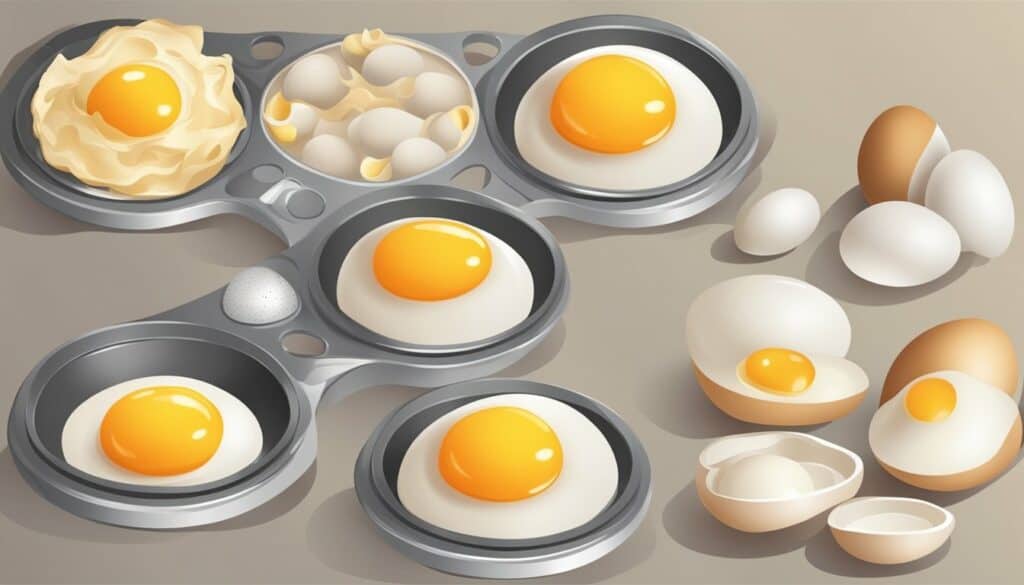How to Cook Eggs in the Oven: A Simple Guide

Table of Contents
Understanding the Basics of Oven Baked Eggs
When it comes to cooking eggs in the oven, there are a few basics that you need to understand to get the best results. Here are some tips to help you get started:
- Preheat the oven: It’s important to preheat the oven to the correct temperature before you start cooking your eggs. This will ensure even cooking and prevent your eggs from sticking to the baking dish.
- Crack the eggs: Crack your eggs into a bowl before adding them to your baking dish. This will make it easier to remove any pieces of shell and ensure that your eggs are evenly distributed.
- Use the right technique: There are a few different techniques you can use to cook eggs in the oven. One popular method is to bake them in a muffin tin. This will give you perfectly shaped eggs that are easy to serve and store.
- Don’t overcook: It’s important to keep an eye on your eggs as they cook to prevent them from overcooking. This can make them tough and rubbery, which is not what you want.
- Experiment with different toppings: Once you’ve mastered the basics of oven-baked eggs, you can start experimenting with different toppings and seasonings to create your own unique recipes.
By following these tips, you’ll be able to cook eggs in the oven like a pro in no time. Whether you’re making breakfast for the family or meal prepping for the week, oven-baked eggs are a delicious and easy option.
Preparation Before Cooking
Before cooking eggs in the oven, it is important to prepare all the necessary ingredients and equipment. Here are the steps I follow:
-
Preheat the oven to 350°F (180°C) to ensure that it is at the correct temperature for cooking the eggs.
-
Choose the ingredients you want to use, such as salt, pepper, and butter. You can also use nonstick cooking spray to prevent the eggs from sticking to the baking dish.
-
Select the appropriate baking dish or muffin tin, depending on the number of eggs you want to cook. You can use a baking sheet or a pan if you don’t have a muffin tin or baking dish.
-
Grease the baking dish or muffin cups with butter or nonstick cooking spray to prevent the eggs from sticking.
-
Set aside a few minutes for prep time to ensure that you have everything you need before you start cooking.
By following these simple steps, you can prepare your ingredients and equipment to cook eggs in the oven with ease.
Cooking Techniques for Eggs in the Oven
When it comes to cooking eggs in the oven, there are several techniques you can use to achieve the desired outcome. Here are some of the most common methods:
- Bake eggs in a ramekin: Crack an egg into a greased ramekin and bake in the oven until the whites are set but the yolk is still runny.
- Bake eggs in a muffin tin: Crack an egg into a greased muffin tin and bake in the oven until the whites are set and the yolk is fully cooked.
- Scrambled eggs: Whisk eggs with your desired seasonings and pour into a greased muffin tin. Bake until set and fluffy.
- Boiled eggs: Place eggs in a muffin tin and bake in the oven at 325°F for 30 minutes. This method is great for making hard-boiled eggs in bulk.
- Fried eggs: Crack an egg into a greased ramekin and bake in the oven until the whites are set and the yolk is fully cooked.
- Poached eggs: Crack an egg into a greased ramekin and bake in the oven until the whites are set but the yolk is still runny.
- Frittata: Whisk eggs with your desired fillings and pour into a greased baking dish. Bake until set and golden brown.
- Egg muffins: Whisk eggs with your desired fillings and pour into a greased muffin tin. Bake until set and golden brown.
No matter which technique you choose, be sure to preheat your oven to the appropriate temperature and grease your baking dish or muffin tin to prevent sticking. Experiment with different seasonings and fillings to create your perfect egg dish.
Recipes for Oven Baked Eggs
I love making eggs in the oven because it’s a quick and easy way to prepare breakfast for a crowd. Here are some of my favorite recipes for oven baked eggs:
-
Classic Baked Eggs: Preheat your oven to 350°F. Crack 2 eggs into a ramekin and season with salt and pepper. Bake for 12-15 minutes, or until the whites are set and the yolks are still runny. Serve with toast or crusty bread.
-
Baked Egg Breakfast Sandwich: Preheat your oven to 400°F. Cut a croissant in half and place it on a baking sheet. Crack an egg into a small bowl and pour it onto the bottom half of the croissant. Top with cheese and bacon or ham. Bake for 10-12 minutes, or until the egg is set and the cheese is melted. Top with the other half of the croissant and serve.
-
Breakfast Burrito: Preheat your oven to 375°F. Line a baking sheet with foil. Whisk together 4 eggs, 1/4 cup milk, and salt and pepper. Pour the mixture onto the baking sheet and bake for 10-12 minutes, or until the eggs are set. Top with shredded cheese, cooked sausage or bacon, and any other desired toppings. Roll up in a tortilla and serve.
-
Baked Egg Tacos: Preheat your oven to 375°F. Line a baking sheet with foil. Crack 2 eggs onto the baking sheet and season with salt and pepper. Bake for 8-10 minutes, or until the whites are set and the yolks are still runny. Serve on warm corn tortillas with salsa, avocado, and cilantro.
-
Egg Salad: Preheat your oven to 350°F. Place 6 eggs in a muffin tin and bake for 30 minutes. Remove from the oven and let cool. Peel the eggs and chop them into small pieces. Mix with mayonnaise, mustard, chopped celery, and salt and pepper. Serve on bread or crackers.
These recipes are all easy to make and perfect for breakfast or brunch. Try them out and see which one is your favorite!

Adding Additional Ingredients
When it comes to cooking eggs in the oven, the possibilities for additional ingredients are endless. Here are some of my favorite options to take your baked eggs to the next level:
- Bacon: Cook some bacon separately and crumble it on top of the eggs for a salty and savory addition.
- Cheese: Sprinkle some shredded cheddar or any other type of cheese on top of the eggs before baking for a gooey and decadent treat.
- Ham or Sausage: Cook and chop up some ham or sausage and mix it into the egg mixture for a heartier meal.
- Potatoes: Add some diced breakfast potatoes or home fries to the bottom of the baking dish for a crispy and satisfying base.
- Sweet Potato Hash Browns: Swap regular potatoes for sweet potato hash browns for a healthier and more flavorful option.
- Spinach or Kale: Add some chopped spinach or kale to the egg mixture for a boost of nutrients and a pop of color.
- Herbs: Mix in some chopped herbs like parsley, chives, or thyme for a fresh and fragrant addition.
- Toppings: Once the eggs are baked, top them with some avocado slices, salsa, or hot sauce for a customizable and delicious meal.
Remember to adjust the cooking time and temperature accordingly based on the additional ingredients you choose to add. Experiment with different combinations and find your perfect baked egg recipe.
Nutritional Information of Oven Baked Eggs
As someone who is health-conscious, I always make sure to know the nutritional information of the food I consume. Here’s the nutritional information for oven baked eggs:
- Serving Size: 1 egg
- Calories: 70
- Total Fat: 5g
- Saturated Fat: 1.5g
- Cholesterol: 185mg
- Sodium: 70mg
- Protein: 6g
Eggs are a great source of protein and are low in calories. They are also rich in vitamins and minerals such as vitamin A, calcium, and iron. However, it is important to note that eggs also contain cholesterol, so it’s recommended to limit your intake if you have high cholesterol.
When baking eggs in the oven, it’s important to avoid adding extra fat or salt. This can increase the calorie and sodium content of the dish. Instead, try adding herbs and spices for flavor.
Overall, oven baked eggs are a healthy and delicious option for breakfast or any meal of the day.
Meal Prep and Storage Tips
When it comes to meal prepping eggs in the oven, there are a few tips that can help you make the most of your time and ensure that your eggs turn out perfectly cooked every time.
-
Meal Prep: Eggs cooked in the oven are a great option for meal prep. They can be made in large batches, and they are easy to store and reheat. To meal prep eggs in the oven, simply follow the recipe as directed, then divide the eggs into individual portions and store them in airtight containers in the refrigerator.
-
Freezing: Eggs cooked in the oven can also be frozen for later use. To freeze eggs, allow them to cool completely, then wrap them tightly in plastic wrap or aluminum foil and place them in a freezer-safe container. When you’re ready to use them, simply thaw them in the refrigerator overnight, then reheat them in the oven or microwave.
-
Doneness: The doneness of your eggs will depend on the cook time and temperature you use. For soft, runny eggs, cook them for 10-12 minutes at 350°F. For firmer, fully-cooked eggs, increase the cook time to 15-20 minutes.
-
Total Time: The total time it takes to cook eggs in the oven will depend on the doneness you prefer. Soft, runny eggs will take around 20 minutes, while fully-cooked eggs will take closer to 30 minutes.
-
Yield: This recipe yields 12 servings, making it perfect for meal prep or feeding a crowd. If you need to make more or fewer servings, simply adjust the ingredients accordingly.
By following these tips, you can enjoy perfectly cooked eggs in the oven every time, whether you’re meal prepping, freezing, or serving them fresh.

Alternative Breakfast Options
If you’re not in the mood for eggs or just want to switch things up, there are plenty of other breakfast options to try. Here are a few alternatives to consider:
- Toast: Toast is a classic breakfast option that pairs well with a variety of toppings, such as butter, jam, or avocado.
- Muffins: Muffins are a great grab-and-go breakfast option. You can make them ahead of time and customize them with your favorite flavors.
- Hash browns: Hash browns are a delicious and filling breakfast option. You can make them from scratch or buy them frozen.
- Waffles: Waffles are a fun and tasty breakfast option. You can top them with fruit, syrup, or whipped cream.
- Deviled eggs: If you want to stick with eggs but want something a little different, try making deviled eggs. They’re a great option for brunch or a special occasion.
- Large eggs: If you prefer your eggs cooked a different way, try cooking them on the stovetop or in the microwave.
There are plenty of breakfast options out there, so don’t be afraid to experiment and find what works best for you.
Adapting Recipes for Dietary Needs
As someone who has experimented with different dietary needs, I understand the importance of adapting recipes to fit your specific needs. Here are some tips for adapting recipes for those with low carb or creamy dietary needs:
Low Carb
- Swap out regular flour for almond flour or coconut flour to reduce carb content in baked goods.
- Use cauliflower rice instead of regular rice for a low-carb alternative.
- Substitute spaghetti squash or zucchini noodles for regular pasta.
Creamy
- Use coconut cream or cashew cream instead of heavy cream for a dairy-free option.
- Add avocado to smoothies or sauces for a creamy texture without dairy.
- Use Greek yogurt instead of sour cream for a healthier and creamier option.
By making simple swaps and substitutions, you can easily adapt recipes to fit your dietary needs without sacrificing flavor or texture.